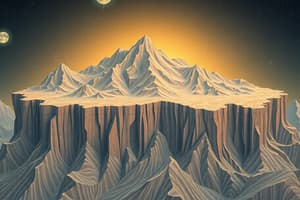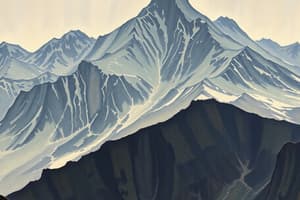Podcast
Questions and Answers
What are the three types of plate boundaries?
What are the three types of plate boundaries?
- Divergent, Convergent, Static
- Convergent, Stratovolcanic, Transform
- Divergent, Convergent, Transform (correct)
- Subductive, Divergent, Transform
What occurs at divergent boundaries?
What occurs at divergent boundaries?
Plates move apart and new oceanic crust is created.
Which type of boundary forms mountains?
Which type of boundary forms mountains?
- Convergent Boundaries (correct)
- Divergent Boundaries
- Static Boundaries
- Transform Boundaries
What drives plate tectonics?
What drives plate tectonics?
Transform boundaries are characterized by plates moving toward each other.
Transform boundaries are characterized by plates moving toward each other.
The ________ scale measures the magnitude of earthquakes.
The ________ scale measures the magnitude of earthquakes.
What are the two main types of earthquakes?
What are the two main types of earthquakes?
What type of volcanic eruption produces lava flows steadily?
What type of volcanic eruption produces lava flows steadily?
Which type of volcano is formed by high-viscosity materials?
Which type of volcano is formed by high-viscosity materials?
Most volcanoes are located along plate boundaries.
Most volcanoes are located along plate boundaries.
How can earthquakes impact volcanic eruptions?
How can earthquakes impact volcanic eruptions?
Flashcards
Divergent Boundaries
Divergent Boundaries
Plates move apart, often at mid-ocean ridges, creating new oceanic crust.
Convergent Boundaries
Convergent Boundaries
Plates collide, causing mountain ranges, ocean trenches, or volcanic arcs.
Transform Boundaries
Transform Boundaries
Plates slide horizontally past each other, commonly along strike-slip faults like the San Andreas Fault.
Mantle Convection
Mantle Convection
Signup and view all the flashcards
Slab Pull
Slab Pull
Signup and view all the flashcards
Ridge Push
Ridge Push
Signup and view all the flashcards
Earthquakes
Earthquakes
Signup and view all the flashcards
Tectonic Earthquakes
Tectonic Earthquakes
Signup and view all the flashcards
Volcanic Earthquakes
Volcanic Earthquakes
Signup and view all the flashcards
Effusive Eruptions
Effusive Eruptions
Signup and view all the flashcards
Explosive Eruptions
Explosive Eruptions
Signup and view all the flashcards
Study Notes
Plate Boundaries
- Types of Plate Boundaries:
- Divergent Boundaries:
- Plates move apart.
- Commonly found at mid-ocean ridges.
- Creates new oceanic crust.
- Convergent Boundaries:
- Plates move toward each other.
- Can form mountains, deep ocean trenches, or volcanic arcs.
- Types:
- Oceanic-Continental: Oceanic plate subducts beneath continental plate.
- Oceanic-Oceanic: Older oceanic plate subducts beneath younger plate.
- Continental-Continental: Both plates collide, forming mountain ranges.
- Transform Boundaries:
- Plates slide past one another horizontally.
- Associated with strike-slip faults.
- Example: San Andreas Fault.
- Divergent Boundaries:
Tectonic Processes
- Mechanisms Driving Plate Tectonics:
- Mantle Convection: Heat from the Earth's core induces convection currents in the mantle, driving plate movement.
- Slab Pull: Denser oceanic plates sink into the mantle at subduction zones, pulling the rest of the plate along.
- Ridge Push: Elevated mid-ocean ridges push adjacent plates away as they form.
Earthquake Activity
- Causes of Earthquakes:
- Movement along faults at plate boundaries.
- Accumulation of stress in rocks until failure occurs.
- Types of Earthquakes:
- Tectonic Earthquakes: Result from tectonic forces.
- Volcanic Earthquakes: Associated with volcanic activity and magma movement.
- Measuring Earthquakes:
- Richter Scale: Measures magnitude.
- Moment Magnitude Scale (Mw): More precise for larger quakes.
- Modified Mercalli Intensity Scale: Measures felt effects and damage.
Volcanic Eruptions
- Types of Volcanic Eruptions:
- Effusive Eruptions: Lava flows steadily from a vent; typically low viscosity (e.g., shield volcanoes).
- Explosive Eruptions: Violent eruptions with ash, gas, and pyroclastic flows; typically high viscosity (e.g., stratovolcanoes).
- Volcanic Landforms:
- Shield Volcanoes: Broad, gently sloping sides, formed by low-viscosity lavas.
- Stratovolcanoes: Steep, conical shapes, formed by alternating layers of lava and ash.
- Cinder Cones: Small, steep-sided hills formed from volcanic debris.
Connections of the Earth
- Relationship Between Plate Tectonics and Volcanism:
- Most volcanoes are located along plate boundaries.
- Divergent boundaries often produce new crust and volcanic activity (e.g., Iceland).
- Convergent boundaries lead to subduction, causing melting and explosive volcanism (e.g., the Pacific Ring of Fire).
- Impact of Earthquakes on Volcanoes:
- Earthquakes can trigger volcanic eruptions by fracturing rock and allowing magma to escape.
- Volcanic activity can induce seismicity due to magma movement.
Plate Boundaries
- Divergent Boundaries: Plates separate, commonly at mid-ocean ridges, producing new oceanic crust.
- Convergent Boundaries: Plates collide, forming geological features such as mountains, ocean trenches, or volcanic arcs.
- Oceanic-Continental Subduction: Oceanic plate subducts under continental plate, leading to mountain formation.
- Oceanic-Oceanic Subduction: Older oceanic plate is subducted beneath a younger plate.
- Continental-Continental Collision: Both plates converge, resulting in mountain ranges.
- Transform Boundaries: Plates slide horizontally past each other, associated with strike-slip faults like the San Andreas Fault.
Tectonic Processes
- Mantle Convection: Core heat creates convection currents in the mantle that drive plate movements.
- Slab Pull: Denser, sinking oceanic plates at subduction zones pull the rest of the plate downwards.
- Ridge Push: Elevated mid-ocean ridges push adjacent plates apart during crust formation.
Earthquake Activity
- Causes: Earthquakes occur from fault movement along plate boundaries and stress accumulation in rocks until failure.
- Types of Earthquakes:
- Tectonic Earthquakes: Result from tectonic forces acting on crust.
- Volcanic Earthquakes: Linked to volcanic activity and the movement of magma.
- Measurement Scales:
- Richter Scale: Indicates the magnitude of an earthquake.
- Moment Magnitude Scale (Mw): Offers precision for larger tectonic events.
- Modified Mercalli Intensity Scale: Assesses the observable effects and damage caused by earthquakes.
Volcanic Eruptions
- Types of Eruptions:
- Effusive Eruptions: Steady lava flows with low viscosity, typical of shield volcanoes.
- Explosive Eruptions: Characterized by violent discharge of ash, gas, and pyroclastic flows, usually from stratovolcanoes.
- Volcanic Landforms:
- Shield Volcanoes: Broad and gently sloping, formed from low-viscosity lava flows.
- Stratovolcanoes: Steep and conical, created through layers of lava and volcanic ash.
- Cinder Cones: Small, steep-sided hills made from volcanic debris.
Connections of the Earth
- Plate Tectonics and Volcanism: Most volcanoes align with plate boundaries; divergent boundaries create new crust and associated volcanic activity, while convergent boundaries cause subduction and more explosive volcanism, such as in the Pacific Ring of Fire.
- Impact of Earthquakes on Volcanoes: Earthquakes can initiate eruptions by fracturing rocks, which allows magma to escape; volcanic activity can also trigger seismic events through magma movement within the crust.
Studying That Suits You
Use AI to generate personalized quizzes and flashcards to suit your learning preferences.




